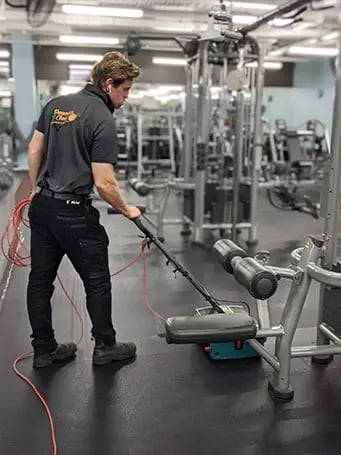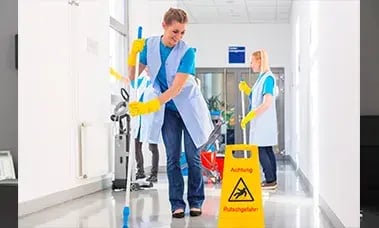
What happens if you don’t clean gym equipment regularly?
You might think a quick wipe-down after a workout is enough. But here’s the truth — neglecting proper gym equipment cleaning isn’t just a hygiene issue; it’s a health, safety, and reputation problem waiting to happen.
According to a 2019 study by FitRated, the average free weight contains 362 times more bacteria than a toilet seat. Most of it’s harmless, but some — like Staphylococcus aureus and E. coli — can cause serious infections. That’s why regular cleaning isn’t a luxury for gyms. It’s non-negotiable.
Why does gym equipment get dirty so quickly?
Gyms are high-contact environments. Every bench, dumbbell, and treadmill handle becomes a bacteria hotspot the moment sweat hits the surface. Add warm temperatures and shared usage, and you’ve got a perfect petri dish.
-
Sweat and body oils create a film that traps dirt and bacteria.
-
Skin cells shed during workouts cling to fabric and grips.
-
Improper ventilation keeps humidity levels high — ideal for mould and mildew.
Even if surfaces look clean, microbes multiply fast. In under 24 hours, bacterial colonies can double — a nightmare for both hygiene and member trust.
What are the health risks of skipping regular cleaning?
Let’s break it down.
1. Skin infections – MRSA, ringworm, and staph thrive on gym mats and benches. Even a small cut can lead to a nasty infection.
2. Respiratory issues – Dust and mould in HVAC vents can trigger asthma or allergies.
3. Cross-contamination – Shared equipment spreads bacteria from one user to another in seconds.
It’s not scare tactics; it’s biology. One poorly cleaned treadmill handle could spread illness through dozens of members by the end of the day.
Can dirty equipment really hurt your business?
Absolutely. Hygiene is now a brand signal. Members equate cleanliness with professionalism and care. In fact, 83% of Australians surveyed by Finder said they’d cancel a gym membership if they felt it wasn’t hygienic.
Neglecting cleaning can lead to:
-
Negative reviews on social media (“Smells bad”, “Sweaty equipment”).
-
Higher churn rates as members seek cleaner alternatives.
-
Regulatory fines for failing health inspections.
This is where perceived value matters. A spotless gym feels premium — even before you upgrade equipment or décor. It’s classic Cialdini “Authority” in play: people trust what looks clean and well-maintained.
How often should gym equipment be cleaned?
Here’s the short answer:
-
High-touch equipment (weights, mats, handles) – after every use.
-
Cardio machines and benches – multiple times daily.
-
Floors and changerooms – daily deep clean.
-
Air filters and vents – monthly maintenance.
That may sound like overkill, but frequency is your insurance policy against infection and bad PR. Many gyms now rely on professional gym cleaning services to manage the workload efficiently and meet compliance standards.
What happens behind the scenes of a professional gym clean?
Good cleaning isn’t just about wiping surfaces. It’s about process. Trained cleaners use hospital-grade disinfectants, electrostatic sprayers, and HEPA-filter vacuums to reach invisible grime and airborne particles.
They follow a structured approach:
-
Pre-clean surfaces to remove sweat and oils.
-
Apply disinfectant and let it dwell (contact time matters).
-
Use microfibre cloths — not old rags — to lift bacteria.
-
Finish with an air-quality check or deodorising mist.
This systematic cleaning is what keeps gyms not just looking clean but microbiologically safe.
Are members responsible too?
Partially, yes. Most gyms now provide wipes or spray bottles so members can clean after use. But this only works with clear signage and culture reinforcement.
Behavioural science backs it up: when people see others cleaning, they’re more likely to do it themselves — a classic case of Social Proof. Positioning wipes near every machine and rewarding staff visibility during cleaning builds that habit loop.
What’s the real cost of neglecting gym hygiene?
Think of it like this: the cost of daily cleaning is predictable. The cost of one infection outbreak, negative review, or lost member isn’t. Reputational damage spreads faster than bacteria.
It’s a simple equation of loss aversion — people remember bad hygiene experiences more vividly than clean ones. Prevention is always cheaper than recovery.
Final thoughts
A clean gym isn’t just about appearances; it’s about trust. Members want to feel safe, cared for, and confident their health isn’t at risk. Regular, professional cleaning makes that promise visible.
If you’re unsure how often your facility should be cleaned or what methods work best, this guide on gym cleaning services breaks it down clearly.
FAQ
1. Can I use household cleaners for gym equipment?
Not ideal. Household sprays may smell clean but often lack the hospital-grade disinfectants needed to kill common gym bacteria.
2. How do I encourage members to clean up after themselves?
Make it easy and visible — wipes at every station, clear signage, and friendly staff reminders.
3. What’s the best time for deep cleaning?
Early mornings or late nights, when foot traffic is lowest. It keeps disruption minimal and ensures thorough sanitation.

